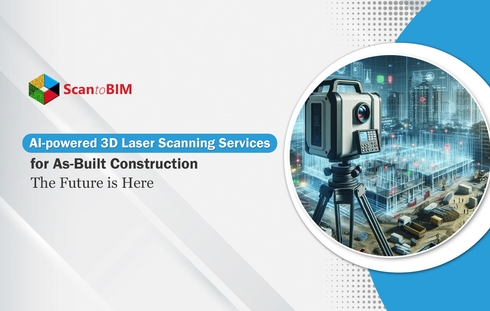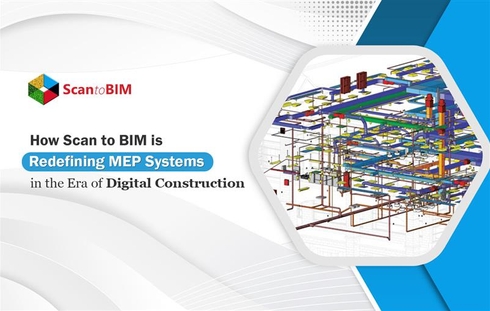
In the world of architecture, engineering, and construction (AEC) evolving at a fast pace, one fact stands firm, precision is the cornerstone of any successful project. The rise of 3D Laser Scanning Services and Scan to BIM services has changed how professionals approach structural analysis, making traditional, labor-intensive methods increasingly obsolete.
But how exactly does this cutting-edge technology deliver greater accuracy, speed, and efficiency to structural assessments?
This article explores how these tools, once seen as futuristic are now integral to modern construction workflows and impact structural integrity.
Scan to BIM Services: Why Accuracy Matters in Structural Analysis
The approach to safety and longevity in a structural analysis lies in precision and accuracy. With Scan to BIM services, AEC firms can convert real-world conditions into highly accurate digital models.
It facilitates an error-free process with quicker decision-making and ensures the designs align with existing site conditions. Scan to BIM is revolutionizing how professionals approach complex projects and their executions.
Precision Redefined: Beyond Manual Measurements
3D Scan to BIM boasts unparalleled accuracy in structural analysis that no other tool can match. Furthermore, unlike manual surveying often fraught with human error, laser scanning involves capturing every detail with utmost precision.
This is particularly crucial in highly complex structures or spaces with extremely tight tolerances as even minor discrepancies can have grave effects.
Structural engineers can now rely on digital models to handle the concerned building or site, facilitating safer designs and a more reliable structure.
Technological advancements in the Scan to BIM space are profoundly changing the approach towards structural analysis and developing a structurally efficient design.
Accelerating Project Timelines: Time is Money
Insufficient existing site data or unbudgeted design conflicts lead to late project completions or undesirable results. According to a report from McKinsey, construction projects using the Scan to BIM services witness 20% faster workflow completion, saving time and other significant resources.
With Point Cloud to BIM, architects and engineers have real-time, accurate site data available that speed up decision-making and eventually the project timeline.
What once required several site visits and manual revisions could now be done remotely with all data at the fingertips of the professionals.
Unlocking Accuracy: Identifying Structural Issues with Scan to BIM Services
Identifying structural issues in existing buildings and enabling professionals to deal with these issues at an early design stage is one of the significant benefits of integrating 3D laser scanning services.

Here’s how laser scanning contributes to structural analysis:
Identifying Settlements and Deformations
Heritage buildings or old structures might face deformations or settlements over time, compromising their structural integrity.
Laser Scanning can detect subtle structural changes, facilitating early identification of potential issues. The professionals can avert additional damage by taking timely action.
Conducting Crack and Vibration Tests
The professionals can precisely measure cracks and vibrations in a structure with 3d laser scanning services. Engineers can analyze the impact on the building’s stability by visualizing these details in the BIM model, enabling them to take proactive measures for damage control. This level of information is critical for devising effective repair and reinforcement strategies.
Executing As-Built Documentation with Precision
For renovation or redevelopment projects, it is essential to capture the intricate details of a building’s geometry and accurately generate the digital representation of its current state.
The Scan to BIM services allow AEC professionals to conduct as-built documentation for such projects precisely.
With the collected data, the team can identify discrepancies between the original design and the actual construction, highlighting the potential structural defects.
Evaluating Material Deterioration
3D laser scanning services can capture the details and intricacies of material deterioration in a structure such as corrosion or wear and tear.
With a detailed analysis of these issues, the professionals can develop suitable maintenance plans and prioritize repairs, ensuring the longevity and safety of the building.
Applications Beyond the Blueprint: Real-World Impact of Scan to BIM Services
3D laser scanning services capture the data of existing structures and convert them into accurate Building Information Models (BIM), extending beyond the traditional blueprint.

Its real-world applications are creating a profound impact, transforming the way AEC professionals design, build, and manage buildings throughout their lifecycle.
Heritage Preservation: Merging the Old with the New
Heritage sites are often fragile, and structural analysis must strike a delicate balance between modern technology and respect for the building’s historical significance.
With 3D Laser Scanning services, architects can capture every minute detail right down to the wear on stones or the curvature of ancient beams without disturbing the structure.
The collected data is then transformed into 3D BIM models, and the project team develops restoration plans adhering to the original building form but making necessary and beneficial amendments to the original design.
Clash Detection and Conflict Resolution: Eradicating Potential Issues
3D Laser scanning services facilitate the analysis of potential defects and errors in existing structures and discrepancies concerning newly devised building plans.
The project teams can catch issues early on by executing a comparative study analysis between as-built models and new design proposals, reducing rework time and cost.
Retrofit Projects: Seamless Juxtaposition of Old and New
Scan to BIM services are reflective of the future of retrofit and renovation projects where dilapidated buildings are juxtaposed with new designs, devising a captivating built form.
A detailed understanding of existing building conditions helps engineers propose upgrades that seamlessly blend into the existing structure.
Towards the Bigger Picture: Structural Analysis for Large-Scale Projects
From towering skyscrapers to sprawling infrastructure projects, Scan to BIM Services has become indispensable in ensuring structural integrity. For large projects, where the stakes are incredibly high, the precision offered by laser scanning is paramount.

On projects like bridges or tunnels, structural engineers use point cloud data to simulate real-world stresses and identify potential weaknesses. This data-driven approach helps ensure safety, durability, and building performance across the lifespan of the structure.
For instance, by analyzing laser scan data, engineers can simulate how a bridge will behave under heavy loads or adverse weather conditions, adjusting designs long before construction begins.
Challenges in Adopting Scan to BIM: Overcoming the Learning Curve
Although 3D laser scanning services and Scan to BIM hold the potential to transform the AEC industry, there are a few hurdles along the way. It is often expensive for small-scale firms to acquire the software and train the team with steep knowledge of BIM and point cloud processing.

The sheer data generated can be voluminous. What follows is processing and converting massive point cloud files into usable BIM models, necessitating the presence of skilled technicians with sophisticated software training in the project team, resulting in a costly affair.
The Future of Structural Analysis: AI and Automation in Scan to BIM
The confluence of 3D Laser Scanning services with artificial intelligence promises to take structural analysis to new heights. AI algorithms can process point cloud data faster and more accurately than ever, automatically identifying structural issues and suggesting design optimizations.
This not only accelerates project timelines but also enhances the safety and sustainability of buildings. As per an analysis report by Inapp, the Maturing of AI-powered Scan to BIM workflows will lead to a 40% reduction in project durations which is predicted as a significant leap forward for the AEC industry.
Adopting Advanced Scan to BIM services with AI
Advanced Scan to BIM services by Scan to BIM.online converts the architectural scans into BIM models in just 1 day with specialized AI tools and plugins. Their team of 100+ architects and engineers specializes in 3D laser scanning services, point cloud to BIM services, and Scan to CAD services.
This proficient team of experts delivers several drawings including floor plans, reflected ceiling plans, and elevations with MEP elements.
The AI-powered Scan to BIM services creates accurate 3d models with LOD 200, 300, and other levels of details, ensuring precise depiction of existing built form.
The AI tools provide unparalleled results while minimizing human intervention, ideal for architectural firms and facilities management.
Success Story of Adopting Advanced Scan to BIM Services with AI
A UK-based educational institute integrated Scan to BIM services by ScantoBIM.online for 200,000 sq ft conversion. The Scan to BIM conversion was completed successfully in 28 days, averaging 7,000 sq ft conversion per day.
An in-house AI tool along with a quality assurance tool was used to minimize human intervention and maintain high quality throughout the process. The Services enabled process optimization, cost reduction, and enhanced profitability for the client.
Conclusion
With high stakes in the construction realm, 3D Laser Scanning services and Scan to BIM services are the most critical tools for structural analysis. Capturing real-time conditions with pinpoint accuracy, improved collaboration, cost efficiency, and time-savings have compelled the widespread use of Scan to BIM services in the industry.
While these technologies remain expensive and complicated, they only grow more sophisticated and user-friendly over time.
As the integration of AI and automation opens up tremendous potential for Scan to BIM, structural analysis should continue to be efficient, data-driven, and precise.








